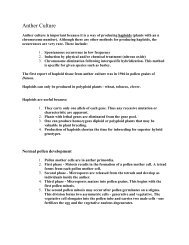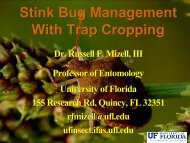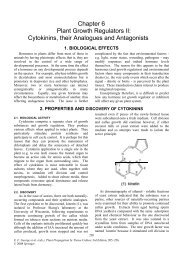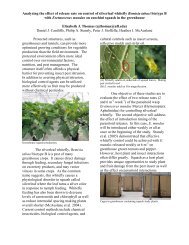The Components of Plant Tissue Culture Media II - Horticultural ...
The Components of Plant Tissue Culture Media II - Horticultural ...
The Components of Plant Tissue Culture Media II - Horticultural ...
Create successful ePaper yourself
Turn your PDF publications into a flip-book with our unique Google optimized e-Paper software.
120 <strong>The</strong> <strong>Components</strong> <strong>of</strong> <strong>Plant</strong> <strong>Tissue</strong> <strong>Culture</strong> <strong>Media</strong> <strong>II</strong><br />
<strong>The</strong> percentage <strong>of</strong> amino acids in a typical yeast<br />
extract is high (e.g. 7% amino nitrogen - Nickell and<br />
Maretzki, 1969; Bridson, 1978; Thom et al., 1981),<br />
but there is less glutamic acid than in casein or other<br />
protein hydrolysate. Malt extract contains little<br />
nitrogen (ca. 0.5% in total).<br />
Yeast extract has been typically added to media in<br />
concentrations <strong>of</strong> 0.1-1 g/l; occasionally 5, 10 and<br />
even 20 g/l (Morel and Muller, 1964) have been<br />
included. It normally only enhances growth in media<br />
containing relatively low concentrations <strong>of</strong> nitrogen,<br />
or where vitamins are lacking. Addition <strong>of</strong> 125-5000<br />
mg/l YE to MS medium completely inhibited the<br />
growth <strong>of</strong> green callus <strong>of</strong> 5 different plants whereas<br />
small quantities added to Vasil and Hildebrandt<br />
(1966) THS medium (which contained 0.6 times the<br />
quantity <strong>of</strong> NO3 – and NH4 + ions and unlike MS did<br />
not contain nicotinic acid or pyridoxine) gave more<br />
vigorous growth <strong>of</strong> carrot, endive and lettuce callus<br />
than occurred on MS. <strong>The</strong>re was still no growth <strong>of</strong><br />
parsley and tomato callus on THS medium: these<br />
tissues only grew well on unmodified MS (Vasil and<br />
Hildebrandt, 1966a,b,c).<br />
Stage I media are sometimes fortified with yeast<br />
extract to reveal the presence <strong>of</strong> micro-organisms<br />
which may have escaped decontamination<br />
procedures: it is then omitted at later stages <strong>of</strong><br />
culture.<br />
Yeast extract has been shown to have some<br />
unusual properties which may relate to its amino acid<br />
content. It elicits phytoalexin accumulation in<br />
several plant species and in Glycyrrhiza echinata<br />
suspensions it stimulated chalcone synthase activity<br />
leading to the formation <strong>of</strong> narengin (Ayabe et al.,<br />
1988). It also stimulated furomocoumarin production<br />
in Glehnia littoralis cell suspensions (Kitamura et al.,<br />
1998). On Monnier (1976, 1978) medium 1 g/l yeast<br />
extract was found to inhibit the growth <strong>of</strong> immature<br />
zygotic embryos <strong>of</strong> Linum, an effect which, when<br />
0.05 mg/1 BAP and 400 mg/l glutamine were added,<br />
induced the direct formation <strong>of</strong> adventitious embryos<br />
(Pretova and Williams, 1986).<br />
Yeast extract is now purchased directly from<br />
chemical suppliers. In the 1930s and 1940s it was<br />
prepared in the laboratory. Brink et al. (1944)<br />
macerated yeast in water which was then boiled for<br />
30 minutes and, after cooling, the starchy material<br />
was removed by centrifugation. However, Robbins<br />
and Bartley (1937) found that the active components<br />
<strong>of</strong> yeast could be extracted with 80% ethanol.<br />
1.7. POTATO EXTRACT<br />
Workers in China found that there was a sharp<br />
increase in the number <strong>of</strong> pollen plants produced<br />
from wheat anthers when they were cultured on an<br />
agar solidified medium containing only an extract <strong>of</strong><br />
boiled potatoes, 0.1 mM FeEDTA, 9% sucrose and<br />
growth regulators. Potato extract alone or potato<br />
extract combined with components <strong>of</strong> conventional<br />
culture media (Chuang et al., 1978) has since been<br />
found to provide a useful medium for the anther<br />
culture <strong>of</strong> wheat and some other cereal plants. For<br />
example, the potato medium was found to be better<br />
for the anther culture <strong>of</strong> spring wheat than the<br />
synthetic (N6) medium (McGregor and McHughen,<br />
1990). Sopory et al. (1978) obtained the initiation <strong>of</strong><br />
embryogenesis from potato anthers on potato extract<br />
alone and Lichter (1981) found it beneficial to add<br />
2.5 g/l Difco potato extract to a medium for Brassica<br />
napus anther culture, but it was omitted by Chuong<br />
and Beversdorf (1985) when they repeated this work.<br />
We are not aware <strong>of</strong> potato extract being added to<br />
media for micropropagation, apart from occasional<br />
reports <strong>of</strong> its use for orchid propagation. Sagawa and<br />
Kunisaki (1982) supplemented 1 litre <strong>of</strong> Vacin and<br />
Went (1949) medium with the extract from 100g<br />
potatoes boiled for 5 minutes, and Harvais (1982)<br />
added 5% <strong>of</strong> an extract from 200g potatoes boiled in<br />
1 litre water to his orchid medium. Of interest was<br />
the finding that potato juice treatment enabled in vitro<br />
cultures <strong>of</strong> Doritaenopsis (Orchidaceae) to recover<br />
from hyperhydricity (Zou, 1995).<br />
1.8. MALT EXTRACT<br />
Although no longer commonly used, malt extract<br />
seems to play a specific role in cultures <strong>of</strong> Citrus.<br />
Malt extract, mainly a source <strong>of</strong> carbohydrates, was<br />
shown to initiate embryogenesis in nucellar explants<br />
(Rangan et al., 1968; Rangan, 1984). Several recent<br />
studies showed a role for the extract in the<br />
multiplication <strong>of</strong> Citrus sinensis somatic embryos<br />
(Das et al., 1995), and in other Citrus spp. (Jumin,<br />
1995), in the promotion <strong>of</strong> plantlet formation from<br />
somatic embryos derived from styles <strong>of</strong> different<br />
Citrus cultivars (De Pasquale et al., 1994), and in<br />
somatic embryogenesis and plantlet regeneration<br />
from pistil thin cell layers <strong>of</strong> Citrus (Carimi et al.,<br />
1999). Malt extract also promoted germination <strong>of</strong><br />
early cotyledonary stage embryos arising from the in<br />
vitro rescue <strong>of</strong> zygotic embryos <strong>of</strong> sour orange<br />
(Carimi et al., 1998). <strong>The</strong> extract is commercially<br />
available and used at a level <strong>of</strong> 0.5 – 1 g/l.






